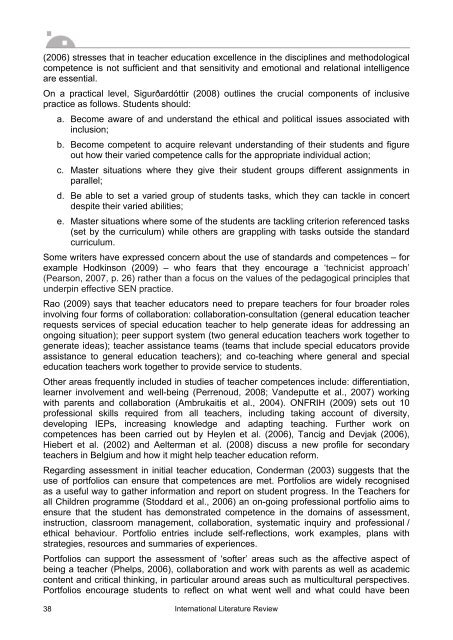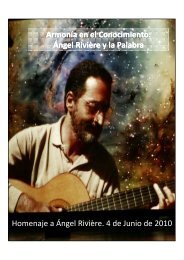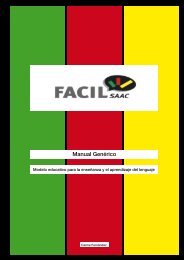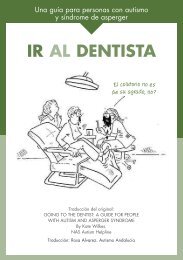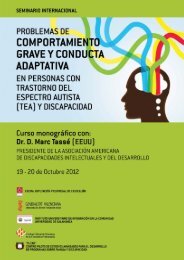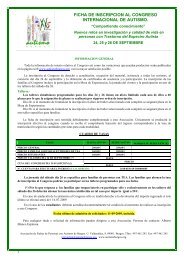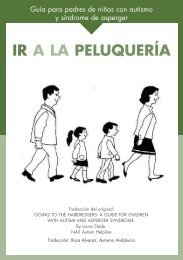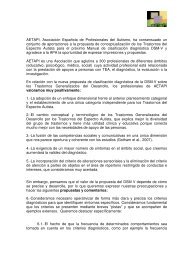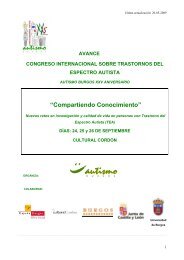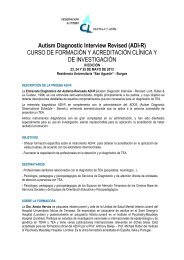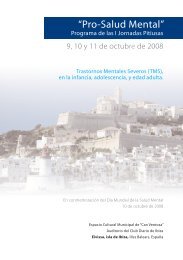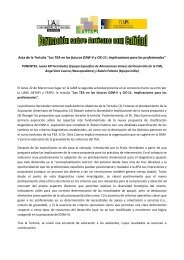TEACHER EDUCATION FOR INCLUSION - Aetapi
TEACHER EDUCATION FOR INCLUSION - Aetapi
TEACHER EDUCATION FOR INCLUSION - Aetapi
Create successful ePaper yourself
Turn your PDF publications into a flip-book with our unique Google optimized e-Paper software.
(2006) stresses that in teacher education excellence in the disciplines and methodological<br />
competence is not sufficient and that sensitivity and emotional and relational intelligence<br />
are essential.<br />
On a practical level, Sigurðardóttir (2008) outlines the crucial components of inclusive<br />
practice as follows. Students should:<br />
38<br />
a. Become aware of and understand the ethical and political issues associated with<br />
inclusion;<br />
b. Become competent to acquire relevant understanding of their students and figure<br />
out how their varied competence calls for the appropriate individual action;<br />
c. Master situations where they give their student groups different assignments in<br />
parallel;<br />
d. Be able to set a varied group of students tasks, which they can tackle in concert<br />
despite their varied abilities;<br />
e. Master situations where some of the students are tackling criterion referenced tasks<br />
(set by the curriculum) while others are grappling with tasks outside the standard<br />
curriculum.<br />
Some writers have expressed concern about the use of standards and competences – for<br />
example Hodkinson (2009) – who fears that they encourage a ‘technicist approach’<br />
(Pearson, 2007, p. 26) rather than a focus on the values of the pedagogical principles that<br />
underpin effective SEN practice.<br />
Rao (2009) says that teacher educators need to prepare teachers for four broader roles<br />
involving four forms of collaboration: collaboration-consultation (general education teacher<br />
requests services of special education teacher to help generate ideas for addressing an<br />
ongoing situation); peer support system (two general education teachers work together to<br />
generate ideas); teacher assistance teams (teams that include special educators provide<br />
assistance to general education teachers); and co-teaching where general and special<br />
education teachers work together to provide service to students.<br />
Other areas frequently included in studies of teacher competences include: differentiation,<br />
learner involvement and well-being (Perrenoud, 2008; Vandeputte et al., 2007) working<br />
with parents and collaboration (Ambrukaitis et al., 2004). ONFRIH (2009) sets out 10<br />
professional skills required from all teachers, including taking account of diversity,<br />
developing IEPs, increasing knowledge and adapting teaching. Further work on<br />
competences has been carried out by Heylen et al. (2006), Tancig and Devjak (2006),<br />
Hiebert et al. (2002) and Aelterman et al. (2008) discuss a new profile for secondary<br />
teachers in Belgium and how it might help teacher education reform.<br />
Regarding assessment in initial teacher education, Conderman (2003) suggests that the<br />
use of portfolios can ensure that competences are met. Portfolios are widely recognised<br />
as a useful way to gather information and report on student progress. In the Teachers for<br />
all Children programme (Stoddard et al., 2006) an on-going professional portfolio aims to<br />
ensure that the student has demonstrated competence in the domains of assessment,<br />
instruction, classroom management, collaboration, systematic inquiry and professional /<br />
ethical behaviour. Portfolio entries include self-reflections, work examples, plans with<br />
strategies, resources and summaries of experiences.<br />
Portfolios can support the assessment of ‘softer’ areas such as the affective aspect of<br />
being a teacher (Phelps, 2006), collaboration and work with parents as well as academic<br />
content and critical thinking, in particular around areas such as multicultural perspectives.<br />
Portfolios encourage students to reflect on what went well and what could have been<br />
International Literature Review


